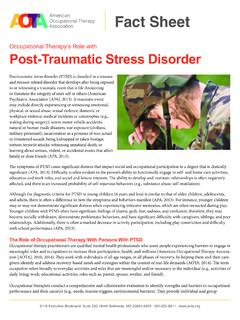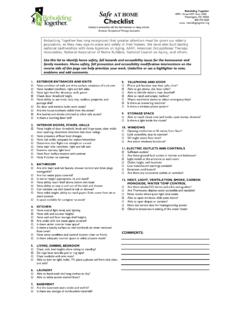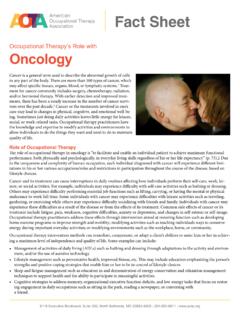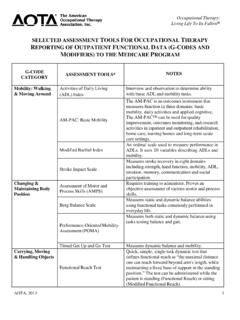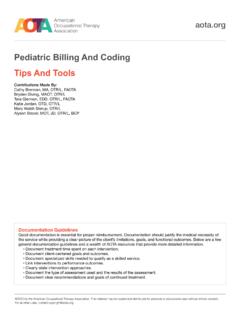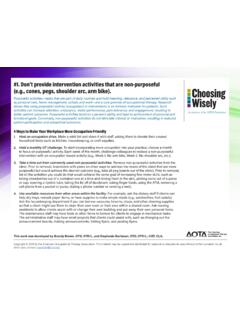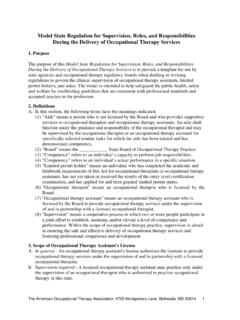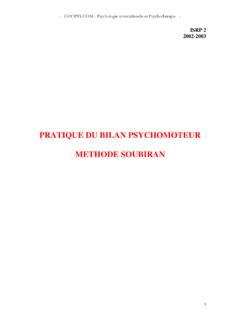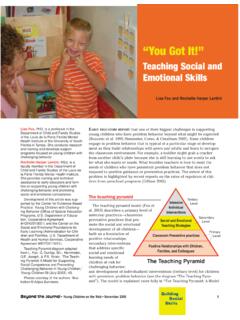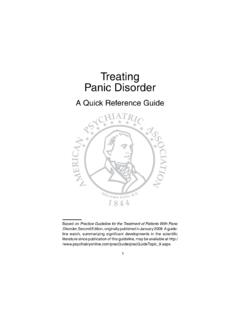Transcription of Frequently Asked Questions (FAQ): What is the Role of ...
1 1 The American Occupational Therapy Association In early intervention, occupational therapy practitioners promote the function and engagement of infants and tod-dlers and their families in everyday routines by addressing areas of occupation, including activities of daily living, rest and sleep, play, education, and social participation. Practitio-ners enhance a family s capacity to care for their child and promote his or her development and participation in natural environments where the child and family live, work, and intervention services and supports are typically provided to children under the age of 3 years and their families. In some states, these services may extend to chil-dren through 5 years of age.
2 Occupational therapy services are most often provided through provisions of the federal Individuals with Disabilities Education Improvement Act of 2004 (IDEA) or in hospitals and outpatient clinics. Although each state can develop their early intervention pro-gram based on state needs and resources, there are minimum components (see 20 , 1435a) that each state must include in their 2008, a cross-disciplinary workgroup of the OSEP TA Community of Practice-Part C Settings developed a mis-sion and a statement, Key Principles for Providing Early Intervention Services in Natural Environments. These key principles (EI principles) are reflected in this document and the practice of occupational therapy in early intervention (Workgroup on Principles and Practices in Natural Environ-ments, 2008).
3 1. What are the core principles of occupa-tional therapy service provided within early intervention and how do they link to the EI principles? While the purposes and outcomes of early intervention occupational therapy may vary based on the settings and funding source, there are core principles that guide all services and supports (Occupational Therapy Practice Framework: Domain and process, 3rd Edition (American Occupational Therapy Association [AOTA], 2014b). These include: n Participation: Occupational therapy services support a child and family s meaningful participation in occupa-tions such as activities of daily living (ADLs), instru-mental activities of daily living (IADLs), education, work, play, leisure, rest and sleep, and social participa-tion.)
4 This relates to the following Key Principles of Early Intervention: Infants and toddlers learn best through everyday experiences and interactions with familiar people in familiar contexts. (EI principle 1)n Occupation: Occupations are the daily life activities in which people engage (AOTA, 2014b, p. S6). Occu-pations are meaningful and purposeful. Infants and toddlers engage in occupations including self-care ( , eating, dressing), rest and sleep, play, social participa-tion, and education ( , pre-literacy, adaptive, cogni-tive, communication, physical, social and emotional development) (Frolek Clark & Kingsley, 2013). Frequently Asked Questions (FAQ): What is the Role of Occupational Therapy in Early Intervention?
5 2Co-occupations are especially important for infants and toddlers and their families. Co-occupations are occu-pations or activities that are shared between children, family members, peers and other adults, and implicitly involve two or more individuals. Examples of co-occupations include feeding and eating, caregiver-child play, dressing, bathing, and hygiene. This relates to the following Key Principles of Early Intervention: Learning opportunities must be functional, based on child and family interest and enjoyment. (Based on EI principle 1)n Family-Centered: The family-centered philosophy is a model whereby the family defines the priorities of the intervention.
6 It is based on the premises that families know their children best, that optimal developmental outcomes occur within a supportive family and commu-nity environment and that each family is unique. This model aligns with the occupational therapy client-cen-tered approach and the value that occupational therapy practitioners place on collaborating with families throughout the service delivery process ( , evalua-tion, intervention, outcomes) (AOTA, 2014b). Occupa-tional therapy practitioners collaborate with the family and other individuals who have knowledge of a child in order to identify a child s strengths and challenges. This relates to the following Key Principles of Early Inter-vention: The consistent adults in a child s life have the greatest influence on their learning and development not EI providers.
7 (Based on EI principle 2)n Family Capacity and Resources: Occupational therapy practitioners support and respect each family s capac-ity and resources. Family capacity includes the knowl-edge and skills the family has to support their child s development and meet their child s needs. Capacity is the amount of physical, emotional and spiritual energy necessary to support the development of a child, and it directly influences the sense of competency a fam-ily member experiences when caring for a young child. Resources include various supports that the family has developed and can use to meet their family and child s needs ( , medical, home, financial).
8 This relates to the following Key Principles of Early Intervention: All families are resourceful, but all families do not have equal access to the resources. Supports need to build on strengths and reduce stressors so families are able to engage with their children in mutually enjoy-able interactions and activities. (Based on EI principle 2) The primary role of a service provider in early inter-vention is to work with and support family members and caregivers in children s lives. (EI principle 3)n Natural Environment: Services under IDEA Part C must be provided in settings that are typical for the child s peers of comparable age, to the extent practica-ble.
9 Whenever possible for the child and family, ser-vices should be provided in a family and/or community setting. Occupational therapy practitioners understand and analyze the interrelated conditions of context and environment and the influence on participation and per-formance. This relates to the following Key Principles of Early Intervention: Infants and toddlers learn best through everyday experiences and interactions with familiar people in familiar contexts (EI principle 1).n Family Routines and Rituals: The Occupational Therapy Practice Framework: Domain and Process, 3rd Edition (AOTA, 2014b) defines routines as patterns of behavior that are observable, regular and repetitive, and that provide structure for daily life (p.)
10 S27). Occupa-tional therapy practitioners promote the participation of children and their families in everyday activities or occupations, such as morning, bedtime, bath time, and playtime routines. When there is a particular area of concern, the occupational therapy practitioner can create an individualized strategy based on the specific needs and priorities of the child and family in order to pro-mote successful participation in daily routines (AOTA, 2013a). Rituals add meaning and purpose and help families build strong relationships. This relates to the following Key Principles of Early Intervention: The early intervention process, from initial contact through transition, must be dynamic and individu-alized to reflect the child s and family members preferences, learning styles and cultural beliefs.
